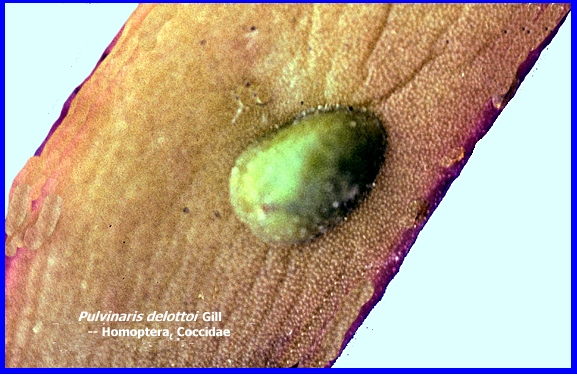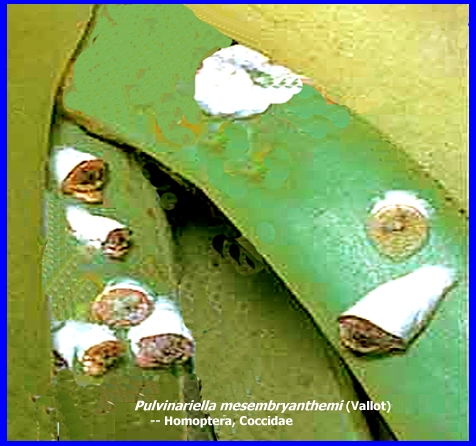FILE: <ch-64.htm> GENERAL INDEX [Navigate to MAIN MENU ]
|
ICE PLANT SCALES Pulvinariella mesembryanthemi
(Vallot) & Pulvinaria delottoi
Gill -- Homoptera,
Coccidae (Contacts) ----- CLICK on Photo to enlarge &
search for Subject Matter with Ctrl/F. GO TO ALL: Bio-Control Cases
Two scale species, Pulvinariella
mesembryanthemi (Vallot) and
Pulvinaria delottoi Gill, originated in
southern Africa where they attack ice plants in the families Aizoaceae and
Crassulaceae. the first species, P. mesembryanthemi has a wide distribution in southern
Europe, the Canary Islands, Germany and South America. Pulvinaria delottoi was first found in California in 1949 at the
University of California Botanical Garden on ice plants, Carpobrotus spp., and reports followed from the Bay Area
between 1949 and 1970 (Tassan et al. 1982).
Frankie and Hagen (1986) note that ice plants are widely used in
California as ornamental groundcovers, with the California Department of
Transportation maintaining ca. 6,000 acres of ice plants along highways.
In 1971 dense populations of P.
mesembryanthemi appeared in
Napa, California. In 1973 a survey of
ice plant along highways in Alameda County was conducted by the Calif. Dept.
of Transportation (Tassan et al. 1982), and it was discovered that there were
really two scale species present. Pulvinaria delottoi has one generation per year and colonizes the
mature lower portions of the plant, while P.
mesembryanthemi has two
generations per year and favors the new terminal growth (Donaldson et al.
1978).
Dahlsten & Hall (1999) reported that by 1976 the scales were
causing considerable damage to ice plants along highways, and in 1978 the
Division of Biological Control at the University of California, Berkeley
began a three-year biological control project funded by the State. As a result seven natural enemies of the
scales were collected in southern Africa and released in California. Two coccinellid species, Hyperaspis senegalensis hottentotta Mulsant and Exochomus flavipes
(Thunberg) failed to establish (Frankie & Hagen 1986). Five encyrtid wasps were liberated: Metaphycus funicularis Annecke, M.
stramineus Compere, Metaphycus sp., Coccophagus cowperi Girault and Encyrtus saliens Prinsloo & Annecke. Metaphycus funicularis and M. stramineus became established throughout California and E. saliens is though to be established in northern California
(Frankie & Hagen 1986). The
impact of the natural enemies has now almost eliminated the need for
insecticidal sprays along freeways in California (Frankie & Hagen 1986). Native encyrtids, Coccophagus spp., the exotic encyrtid Metaphycus helvolus
(Compere), introduced from South Africa in the 1930's for control of black
scale on citrus, and an exotic coccinellid, Cryptolaemus montrouzieri
Mulsant, released for control of mealybugs on citrus also attack the ice
plant scales in California. Application of malathion bait sprays during
the Mediterranean fruit fly eradication program in 1980-1982 were shown to
reduce parasitism by Coccophagus
lycimnia (Walker) (79%) and M. stramineus (90%) (Washburn et al. 1983, Hoy & Dahlsten
1984, Dahlsten & Hall 1999). REFERENCES: [Additional references may be found at: MELVYL
Library ] Dahlsten, D.
L. & R. W. Hall. 1999. Biological
control of insects in outdoor urban environments. In Bellows, T.
S. & T. W. Fisher (eds.), Handbook
of Biological Control: Principles and
Applications. Academic Press, San
Diego, New York. 1046 p. Donaldson, D.
R., W. S. Moore, C. S. Koehler & J. L. Joos. 1978. Scales threaten ice plant in Bay
Area. Frankie, G. W.
& K. S. Hagen. 1986.
Ecology and biology of iceplant scales, Pulvinaria and Pulvinariella
in California. Calif. Dept. of
Transportation, Div. of Highway Maintenance, Sacramento, California (Report
No. FHWA-CA-HM-OZ). 47 p. Hoy, J. B. & D. L. Dahlsten. 1984.
Effects of malathion and Staley's bait on the behavior and survival of
parasitic Hymenoptera. Environ. Ent.
13: 1483-86. Tassan, R. L., K. S. Hagen and D. V. Cassidy. 1982.
Imported natural enemies established against ice plant scales in
California. Calif Agric 36:16-17. Washburn, J. A., R. L. Tassan, K. Grace, E.
Bellis, ... 1983. Effects of
malathion sprays on the ice play insect system. Calif. Agric. 37(1-2):
30-32. |

